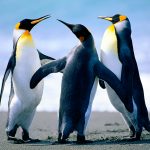The OA is E. But I think the last line of the passage contradicts it. Why is A wrong?
Social learning in animals is said to occur when direct or indirect social interaction facilitates the acquisition of a novel behavior. It usually takes the form of an experienced animal (the demonstrator) performing a behavior such that the native animal (the observer) subsequently expresses the same behavior sooner, or more completely, than it would have otherwise. One example of social learning is the acquisition of preferences for novel foods. Some experiments have suggested that among mammals, social learning facilitates the identification of beneficial food items, but that among birds, social learning helps animals avoid toxic substances. For example, one study showed that when red-wing blackbirds observed others consuming a colored food or a food in a distinctly marked container and then becoming ill, they subsequently avoided food associated with that color or container. Another experiment showed that house sparrows consumed less red food after they observed others eating red food that was treated so as to be noxious. Studies on non-avian species have not produced similar results, leading researchers to speculate that avian social learning may be fundamentally different from that of mammals. But Sherwin’s recent experiments with domestic hens do not support the notion that avian social learning necessarily facilitates aversion to novel foods that are noxious or toxic. Even when demonstrator hens reacted with obvious disgust to a specific food, via vigorous head shaking and bill wiping, there was no evidence that observers subsequently avoided eating that food. Sherwin’s research team speculated that ecological or social constraints during the evolution of this species might have resulted in there being little benefit from the social learning of unpalatability, for instance, selective pressures for this mode of learning would be reduced if the birds rarely encountered noxious or toxic food or rarely interacted after eating such food, or if the consequences of ingestion were minimal. In a related experiment the same researchers showed that if observer hens watched demonstrator hens react favorably to food of a particular color, then observer hens ate more food of that color than they ate of food of other colors. These results confirmed that avian species can develop preferences for palatable food through social learning.Social learning in animals is said to occur when direct or indirect social interaction facilitates the acquisition of a novel behavior. It usually takes the form of an experienced animal (the demonstrator) performing a behavior such that the native animal (the observer) subsequently expresses the same behavior sooner, or more completely, than it would have otherwise. One example of social learning is the acquisition of preferences for novel foods. Some experiments have suggested that among mammals, social learning facilitates the identification of beneficial food items, but that among birds, social learning helps animals avoid toxic substances. For example, one study showed that when red-wing blackbirds observed others consuming a colored food or a food in a distinctly marked container and then becoming ill, they subsequently avoided food associated with that color or container. Another experiment showed that house sparrows consumed less red food after they observed others eating red food that was treated so as to be noxious. Studies on non-avian species have not produced similar results, leading researchers to speculate that avian social learning may be fundamentally different from that of mammals. But Sherwin’s recent experiments with domestic hens do not support the notion that avian social learning necessarily facilitates aversion to novel foods that are noxious or toxic. Even when demonstrator hens reacted with obvious disgust to a specific food, via vigorous head shaking and bill wiping, there was no evidence that observers subsequently avoided eating that food. Sherwin’s research team speculated that ecological or social constraints during the evolution of this species might have resulted in there being little benefit from the social learning of unpalatability, for instance, selective pressures for this mode of learning would be reduced if the birds rarely encountered noxious or toxic food or rarely interacted after eating such food, or if the consequences of ingestion were minimal. In a related experiment the same researchers showed that if observer hens watched demonstrator hens react favorably to food of a particular color, then observer hens ate more food of that color than they ate of food of other colors. These results confirmed that avian species can develop preferences for palatable food through social learning.
It can be inferred that the author of the passage would be most likely to agree with which of the following statements regarding the results of the recent experiments conducted by Sherwin’s research team?
A. The experiments demonstrate that social learning in avian species facilitates the identification of noxious or toxic foods.
B. The experiments suggest that social learning has made avian species less adept than nonavian species at learning to prefer beneficial foods and avoid noxious and toxic foods.
C. The experiments undermine the notion that most avian species have evolved in environments where there is little benefit to the social learning of unpalatability.
D. The experiments suggest that the acquisition of food preferences in avian species is largely unaffected by social learning.
E. The experiments show that social learning in avian species can promote the preferential consumption of beneficial foods but do not support the claim that social learning in avian species promotes the avoidance of noxious or toxic foods.
“But Sherwin’s recent experiments with domestic hens do not support the notion that avian social learning necessarily facilitates aversion to novel foods that are noxious or toxic. Even when demonstrator hens reacted with obvious disgust to a specific food, via vigorous head shaking and bill wiping, there was no evidence that observers subsequently avoided eating that food. Sherwin’s research team speculated that ecological or social constraints during the evolution of this species might have resulted in there being little benefit from the social learning of unpalatability, for instance, selective pressures for this mode of learning would be reduced if the birds rarely encountered noxious or toxic food or rarely interacted after eating such food, or if the consequences of ingestion were minimal. In a related experiment the same researchers showed that if observer hens watched demonstrator hens react favorably to food of a particular color, then observer hens ate more food of that color than they ate of food of other colors. These results confirmed that avian species can develop preferences for palatable food through social learning.”
Clearly, tell us the answer is E and not A. I am not sure what the confusion is.
The observer hens don’t worry if the demonstrator hens don’t eat but follow when the latter shows a preference.
Arun


